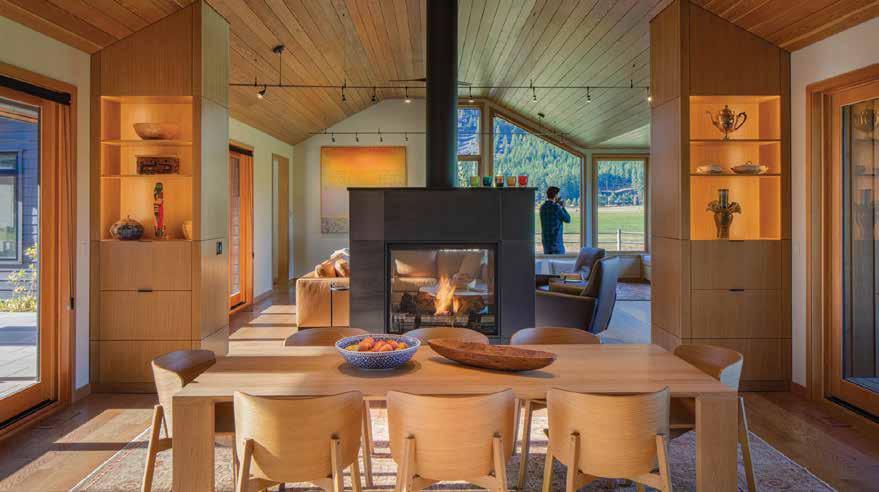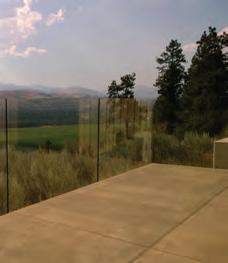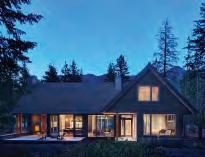














Many forces are at work in the Methow Valley housing market: nature (fires and climate change); the “zoom town” phenomenon; supply-and-demand challenges; higher interest rates; and an urgent need to provide homes for local residents and workers.
Methow Home 2024 touches on all those topics and more, as we attempt to give a comprehensive view of the housing landscape in the valley. Meanwhile, building methods also continue to evolve as owners, architects and contractors adopt more sustainable practices. That theme intersects with many of the articles in Methow Home 2024.
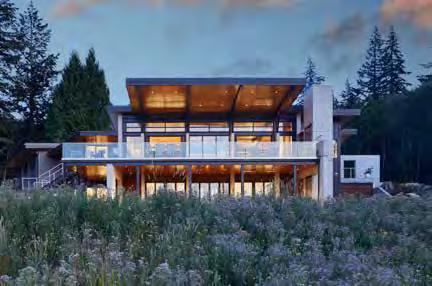
We are also once again featuring a variety of home “profiles” to explore the aspirations of homeowners (full- and part-timers a like), the creativity of architects and the craftsmanship of our local builders. They range from a small, efficient cabin to the unique Berm House.
You’ll also find articles about
practical considerations such as insurance, “dark sky” lighting and Firewise planning. And for an upclose look at some of the valley’s intriguing homes, check out the 2024 Methow Valley Home Tour, with the theme “ARTfully designed in Winthrop,” offered by The Confluence: A rt in Twisp in July. Homes on the tour feature a variety of architectural styles, building materials, sizes and landscapes.
We appreciate the assistance of everyone who helped us put Methow Home 2024 together — architects, builders, owners, writers and photographers, and designer MyKenzie Bennett. Like building a home, a lot of parts go into the assembly of a magazine. Putting them together is complicated but rewarding.
We again extend thanks to our loyal advertisers. They include locally owned businesses that provide jobs and support the local economy, and businesses that have developed a substantial presence in the valley by providing quality products or services. Methow Home 2024 is a handy, year-round guide to the businesses that are here to assist you.
Don Nelson Publisher/Editor

7 Low-profile, high ideals
Super-efficient Berm House reflects a vision of community

17 Collaborating on homebuilding efficiency ideas
Building Science Group gathers industry pros to brainstorm

10 Lo st River finds its way to Firewise certification
Remote community responded to wildfire threats

1 9 ‘ARTfully designed in Winthrop’ is theme for 2024 Methow Valley Home Tour

15 Settling into the landscape
Tiny leaf packs lots of charm into a small space
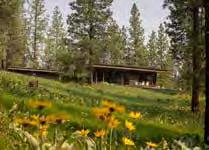
21 Among the wildflowers
A peaceful getaway at ease with the land

26

28 Real estate is still finding its way
Prices,

32
MVN CONTRIBUTORS
Ann McCreary
Freelance writer
Ashley Lodato
MVN columnist
Joanna Bastian
MVN columnist
Michelle Schmidtke
MVN columnist
Shelley Smith Jones
MVN columnist
Sandra Strieby
OTHER CONTRIBUTORS
Okanogan Conservation District
Methow Valley Housing Solutions Network
Methow Conservancy
Ray & Mary Johnston

35

43
41

47
 Photos courtesy of CAST Architecture
Photos courtesy of CAST Architecture

hree miles down valley from Mazama, the Berm House was built with sustainability in mind.
Reflecting its owner’s curious nature, inventive mind and ongoing willingness to explore ideas, the house goes beyond resource conservation and pollution prevention
to engage in sustaining community, farmland and connections to the landscape.
The house’s owner worked with architect Matt Hutchins of CAST Architecture and builder Lucas Evans of Methow Valley Builders Inc. to create a house that draws on science while meeting the needs of the developing cohousing community of which it’s a part. The team members worked together to balance the Berm House’s impact on the larger landscape with the needs of the community’s inhabitants.
Designed for energy efficiency, the Berm House employs concrete and cross-laminated timber (CLT) to create thermal mass, and ultra-tight construction to retain heat in winter and keep the interior cool in summer.
Although the form of the house is simple, the structure involved careful engineering and precision construction to support the berm and roof and prepare for installation of pre-built CLT panels. Post-andbeam construction keeps the main living spaces open and airy and
lets them take advantage of natural light, as well as solar gain, that come from a southwest-facing wall of windows and generous glazing in the building’s other exposed walls.
The concrete work was the most complicated and challenging part of the project, said Evans, entailing a 16-foot retaining wall that forms the back of the building and its crawl space and supports the berm.
Five Star Concrete Construction’s JR Barnhart and his crew did “an outstanding job,” said Evans.
Noting that the precut elements of the house allowed “no room for


error,” he lauded the precision with which the concrete crew worked “right at the beginning” of the project to prepare for placement of the beams and panels.
CLT is a relatively new material, and one not typically used for residential construction. Fabricated from small-diameter timber, it makes use of wood that has typically not been profitable to harvest, said Evans. That wood might otherwise be burned as part of post-logging clean-up or left standing, creating a wildfire risk.
Incorporating the material in buildings sequesters the carbon in
the trees so it’s not released to the atmosphere, said Evans, and creates a market for small-diameter wood, making forest thinning cost-effective while contributing to forest health and local economies.
The house’s CLT roof panels were supplied by Vaagen Timbers in Colville. The owner worked closely with Vaagen to identify exactly what components the house would need so the material could be fabricated in advance for delivery to the site and installation once the concrete was in place.
When the order had been agreed on, Vaagen used a computer
an open field, with territorial views down the Methow Valley and up to McKinney Ridge. The namesake berm shields the house from the adjacent access road and minimizes its visual presence. It also provides additional insulation and fire protection, and a defense against winter weather.
And it’s an important design feature, connecting the house to the surrounding landscape, emphasizing the entry, and creating a rooftop space where people can relax and enjoy the view. Clad with rough stone gathered on the building site and surrounding land, it mirrors the rugged rock walls that rise on either side of the valley and, from the road, reveals just a hint of the house sheltered beneath it.
numerical control cutter to produce precisely sized panels weighing thousands of pounds apiece. Jerry Palm of Palm Construction placed the panels, bringing “the perfect training” for that work to the job, said Evans.
Together, the large volume of concrete, posts, beams, and CLT panels creates both the building’s superstructure and the thermal mass that is central to what’s referred to as Passive House design. Solar gain in summer is limited by a wide overhang on the building’s southwest wall.
The house was sited to take full advantage of the low winter sun, which penetrates beneath the overhang to warm the house’s interior. Continuous insulation, extending beneath the crawlspace as well covering the roof and exterior walls, keeps the building air-tight to reduce unwanted heat exchange with the outdoors.
A Passive House typically requires “30% to 40% of the energy input that you might see under a comparable, high-performance building under current code,” said Hutchins. In the Methow Valley, where summer days are hot and winter temperatures are among the coldest in the state, that adds up to a substantial savings in energy use, and cost.
The Berm House sits more than 100 yards from Highway 20, facing
A split in the berm provides access to the house and a view straight through to the open field and evergreen forest beyond. The berm itself extends across the roof of the house; stone steps provide access, and a surface of sand creates what the owner suggests may be “the only beach in the upper Methow.”
Eventually, the top of the berm will be home to a building that served as one of the Methow Valley’s original schoolhouses. More than a caprice, the schoolhouse on the roof is meant to represent a link between the modern structure grounded in science and the valley’s history. It will also be a shelter and retreat for community members and guests.
The Berm House’s owner began visiting the Methow Valley in the early 1970s, and he and his late wife moved to the valley in 2000. They bought farmland near Mazama and later acquired the adjacent land, site of the former Liberty Bell Campground.
The couple became interested in cohousing, a form of intentional community that includes individual dwellings and a shared space for gatherings and, often, overnight stays by guests. The owner has pursued the idea with development of the McKinney Ridge community and the Berm House.
To date, McKinney Ridge includes eight houses developed by the Methow Housing Trust and 10 as-yet undeveloped lots, most of which will probably be sold for market-rate housing. The Berm House, measuring 3,130 square feet, is designed and
scaled to serve as the community’s gathering place, with a kitchen and great room large enough for groups on one side of the entry and four bedroom suites, to accommodate the owner and guests of McKinney Ridge residents, on the other.
Each suite includes a bathroom and kitchenette and a Murphy bed that folds into the wall to create extra space during the day. The owner’s suite is similar; its Murphy bed includes a desk that can be pulled out from the underside for use when the bed has been tucked away, allowing the room to double as an office.
The house’s interior is spacious and lightly furnished, finished with a simple palette of light, mid-tone, and dark woods. The ceilings are the same CLT panels that bear the weight of the walk-on roof, with the supporting posts and beams exposed. Walls are clad in Europly birch and maple plywood panels, attached with stainless steel screws and easily removed for access to plumbing or electrical systems.
The electrical system itself, installed by Tamarack Electric Inc., includes “a lot of very high-end and specific detail-oriented wiring,” said Evans. That complex wiring is
needed to supply the demands of the large house and the sophisticated mechanical system that’s integral to the Passive House design.
Evans described the panels as more durable than drywall and “a little more futureproof” since they’re easy to replace if damaged, without requiring the patching and repainting that a conventional wall repair entails. The panels are “very utilitarian,” he said, but also “clean and linear and crisply executed,” reflecting the house’s focus on livability coupled with efficiency.
T he exposed faces of the structure are dark wood and glass. The house is clad with Shou Sugi Ban siding — wood that’s been charred to enhance its resistance to fire. Shou Sugi Ban is a Japanese technique that has also been used in Scandinavia and other parts of Europe for centuries, said Evans. The charring process hardens the wood, making it resistant to insects and rot as well as developing a layer of charcoal that resists ignition, he said.
In addition to providing shelter from the sun, the house’s southwest-facing overhang creates an area in which snow is less likely to accumulate in winter, protecting
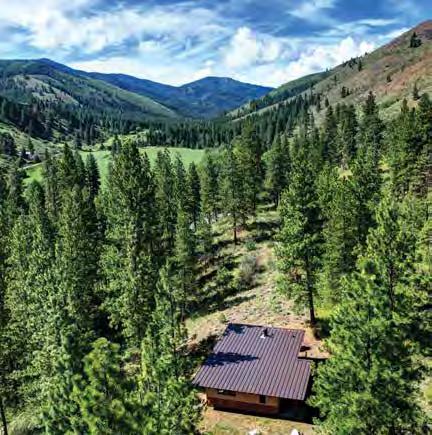

the house and contributing to ease of movement for people outside. Beneath the overhang, a concrete apron is both a walkway and a fire protection feature. The apron opens to an irrigated lawn to create an additional barrier in case of wildfire, as well as easing the visual transition to the fields beyond and, with a patio at the southeast end of the house, providing outdoor living space.
The Berm House is a multi-functional space designed to meet the present needs of an evolving
community. It also celebrates the community’s connection to the larger landscape of the Methow Valley, the site’s agricultural heritage, and the history of human settlement in the valley.
Built to endure and ensconced in the earth, the Berm House is central to the owner’s long-range vision for McKinney Ridge as “an example of how we might live together differently,” and promises to become part of an ongoing legacy of human adaptation to and enjoyment of a place that’s both challenging and beautiful.

It’s not quite the end of the road, but the Lost River Airport and surrounding homes are, for many, the last bit of civilization you’ll encounter as you make your way up into the Pasayten Wilderness following the natural taper of the Methow Valley into the Cascades.
Right where the Lost River meets the Methow River, a little over 6 miles northwest of Mazama, a cluster of recreational cabins, homes, and pretty much any other style of living one would expect in the Methow Valley straddles a long airstrip amongst the ponderosa pines and Douglas fir.
There’s a lot of peace seemingly at the end of the road, but there are also challenges that come from isolation. Wildfire is a frequent force on the landscape of the Methow Valley and beyond, but when you’ve got one way in and one way out, the calculus of reducing and mitigating risk becomes a bit more complicated.
Since the 2021 Cedar Creek and Cub Creek 2 fires, the Lost River Airport Association residents and their partners with the Okanogan Conservation District and Washington Department of Natural Resources (DNR) have worked to develop a path forward for the community to live on the landscape with fire.
The area around Lost River isn’t a stranger to wildfire; the 1986 Eureka Fire and 2003 Needles Fire both came close to singeing the edges of the ridges overlooking the community, and the airstrip played a role in suppressing both blazes.
On July 8, 2021, lightning strikes sparked the Cedar Creek Fire; eight days later, the human-sparked Cub Creek 2 fire was ignited and compounded firefighting efforts

and residential concerns up and down the Methow, especially for the neighborhoods near Mazama, who watched as Cedar Creek blazed atop the ridges along the valley’s southern rim. While firefighting efforts and the eventual coming of winter snows snuffed out both blazes, questions still flew like sparks from many residents around Mazama, particularly Lost River.
What happens if a fire sparks in the upper portions of the valley and burns southward? How vulnerable is my home, my community, to fires?
In the aftermath of the 2021 fires, those questions were asked aloud within the Lost River community by many folks, including Pamela Saxton and Maria Hines.
“We knew we needed to do something,” Saxton said as the immediate threat and stress of the fires faded, but the realities of living with fire on the landscape remained for the last little community on the road to the wilderness.
The association itself worked to ensure the maintenance of the community; it lacked an evacuation plan. Challenges for coordinating
across the community were easily apparent, not just because of its location but the distribution of full and part time residents, different building styles, access to cell service, and other factors.
Recognizing the need for outside help, a chain of conversations began that would lead Lost River towards becoming more, literally and figuratively, Firewise.
Just down the road from Lost River along Goat Creek Road sits the Edelweiss development, one of the largest neighborhoods in the northern Methow Valley and a leading Firewise USA community since 2019. Conversations with Edelweiss residents led conversations with Kat Heim at Fire Adapted Methow Valley (FAMV).
Heim and FAMV frequently play a match-making role in the fire resiliency world of the Methow, connecting community members with the Firewise USA program, agency staff, and anybody else who might assist them in their fire resiliency journeys.
In the case of Lost River, the match was first made in October of 2022 with Guy Gifford, the DNR assistant division manager for community resilience and prevention, and Eli Loftis, the wildfire program lead for the Okanogan Conservation District.
Facilitated by FAMV, Loftis, and Gifford met Saxton, Hines, and other Lost River residents at the community fire hall. In a roundtable discussion, just minus a round table, community members told the agency staff about their concerns, their successes, and their hopes for what a more fire-resilient Lost River might look like.
Some spoke about challenges with evacuations on a one way in one way out road; others asked about funds to assist in removing fuels around homes and the fire hall.
The elements for a Firewise USA site began to come together: form a council, establish boundaries, have a community risk assessment, form
a plan, and get certified.
After an abortive attempt to perform the community risk assessment in November 2022, canceled by the sudden arrival of half a foot of snow in the Mazama area the morning of the assessment, Conservation District and DNR staff returned to Lost River in May 2023 to assess the community’s strengths and weakness for handling wildfire on the landscape.
The assessment was pleasurably unusual for Loftis, who was joined by DNR’s Jake Hardt, as several Lost River residents took notice of the two foresters roaming about with clipboards and pens in hand and struck up conversations. Their active engagement with the assessment process allowed Loftis and Hardt to gain greater context for specific elements of the community’s fire resiliency.
Three distinct vegetative zones were identified, each with its challenges for managing fuel loads. It was noted Lost River has an abundance of western red cedar, a species that is both highly vulnerable to wildfire and is threatened by










climate change, and that Douglas fir was overly abundant in several areas. Many of the homes had more pluses than minuses regarding vulnerability to embers or direct flame contact, but as always, there was room for improvement.
Finished in the early summer, the report produced by the Conservation District and DNR highlighted Lost River’s successes thus far in working towards fire resiliency and also provided recommendations for the future.
Including the creation of additional defensible space around structures, the selective cutting of overly stocked Douglas fir stands to reduce fuel loads and give the more fire and drought-resistant ponderosa pines more room to grow, and special management of the red cedars.
T he final recommendation was paramount: “Continue with the process of receiving formal certification f rom NFPA (National Fire Protection Association) as a Firewise USA site.”
Taking the report and running with it, Saxton, Hines, and other Lost River residents worked to develop a community action plan based on the agency’s recommendations.
That August, the need for community planning for wildfire response was demonstrated when a fifth-wheel trailer caught fire. The response was rapid. The property owner called 911 when it became clear that a simple hose wouldn’t stop the flames. Others worked to pull material away from the trailer, and others took to Lost River’s roads as bicycle-mounted Paul Reveres warned of the potential of the fire to spread.
The wind could carry the embers

far if it kicked up suddenly. Thankfully, within 20 minutes of the 911 call, Okanogan County Fire District 6 firefighters arrived to douse the flames. It was a close call, and it reinforced the determination of many in the community to work towards greater fire resiliency.
In the aftermath of the August fire and the risk assessment, multiple community meetings were held with residents and Loftis and DNR’s Will Knowlton. Many questions about the future of fire resiliency remain to be answered, including concerns about evacuation and forest management.
Residents were encouraged to sign up for home risk assessment from Okanogan Conservation District, and many did and continue to, making Lost River one of the most heavily assessed neighborhoods in the Methow Valley. Residents began to work on removing potential fuels with gusto.
“I’ve never heard so many chainsaws,” said Hines.
Grants for additional resilience measures were discussed, and the action plan was finalized. In the first week of November 2023, Lost River Airport Association became the newest Firewise USA certified community in Okanogan County, joining a collection of collaborative neighbors, agencies, and partners that now stretches from Lost R iver south to Okanogan’s oldest Firewise community, Chiliwist.
“Living here is our paradise and dream,” said one Lost River resident. Paradise can come with challenges, and for the residents of Lost River, the challenges of living with wildfire on the landscape a re many but not insurmountable.
Lost River isn’t a lost cause. The work and determination of Lost River’s residents, their agency partners, and other communities demonstrates the value of collective action to work towards a future where people can live and recreate in a place like the Methow, where fire is a natural force on the landscape, and a d ream can be up long roads amongst the trees.
Eli Loftis is the Wildfire Community Resiliency Lead for The Okanogan Conservation District. With special thanks to Pamela Saxton, Maria Hines, and Kathryn Heim for their contributions to this article.






 Photos by Ben Lindbloom
Photos by Ben Lindbloom

Drawn to her property in the Methow Valley for its dramatic views, opportunities for year-round recreation, and proximity to mountain biking and cross-country skiing access, Catherine
Humblet had plans to build a 1,200-square-foot home on her property in Mazama before the COVID epidemic.
But, as she considered her requirements, she changed her mind. She realized, she didn’t need “the big house,” a house she dubbed “Arrowleaf.” Thus, the concept for
a much smaller house, “Tiny Leaf,” was born.
“It’s just me and my dog,” she said. “And I don’t have much stuff.”
Humblet wanted a home that blended in with its surroundings — a lightly wooded hillside in Edelweiss — was energy and space efficient, and around 300 square feet. She intended to use it primarily as a vacation home, but as things
turned out, she lived in Tiny Leaf for three years during COVID. She took her design ideas for Tiny Leaf to the Seattle-based architecture and design firm, GO’C. GO’C profiles itself as, “An award-winning architecture and design studio inspired by the interplay of rational design and artistic expression. Our mission is to cultivate a collaborative design ethos dedicated to
producing expressive and contextual architecture that enriches its place.”
Founding architects of GO’C, Jon Gentry and Aimée O’Carroll, took on Humblet’s project. GO’C’s project narrative and photographs of Humblet’s 15-by-22 foot cabin can be found on their website.
“A strong relationship to the topography and a response to the drastically different seasons was key to the design,” said Jon Gentry. Tiny house’s exterior, a three-sided-flat-roofed structure bermed into the hillside with cast-in-place concrete panels and steel cladding, reflects Humblet’s desire to have a home that would blend into its surroundings and age gracefully with time to resemble the surrounding landscape.
L arge glazed sliding doors and a flat roof that doubles as a roof deck, are features that enhance Tiny Leaf’s connection with the outdoors. “With such a small footprint, it was important to maximize the connection with
the outdoors to expand the living area during the shoulder months,” the architects said.
Humblet hired a local firm, Big Valley Builders, to construct Tiny Leaf, but she finished the interior herself. To maximize the interior space, everything is as utilitarian and efficient as a ship’s cabin.
Clever storage space is built into the bed and walls. As stated in the project narrative: “Pull-out side panels from the thickened wall that separates the kitchen and bathroom create a pantry and utility storage for the main space and bathroom storage on the opposite side.” The whole interior space has a rosy glow from n atural light that enters the space from the exterior glazing and a linear skylight.
If you’re looking for a low-impact vacation cabin with a small footprint, a temporary dwelling while you’re building your main home that can be turned into a guesthouse, or just a cozy tiny house as inconspicuous as a bear’s den, Tiny Leaf would be an ideal choice.



Agroup of Methow Valley builders, designers and architects has formed a community organization to learn and share ideas about designing and building energy-efficient, durable, and easy-to-run houses.
The brainchild of architect Margo Peterson-Aspholm, the Methow Valley Building Science (MVBS) group formed about a year ago to explore best practices for energy-efficient building. Initially a trio comprised of Peterson-Aspholm of Prentiss
Balance Wickline Architects, Kit Kollmeyer of Serious Fun Studio, and Jeremy Newman of Intrinsic Design, the MVBS group now includes anywhere from a dozen to two dozen participants in its monthly meetings.
Peterson-Aspholm was inspired to start the group by the “passive house” training she’s undertaking. Passive house is a voluntary standard for energy efficiency, aimed at creating buildings that take minimal energy to heat and cool, resulting in a reduced ecological footprint. Passive houses have in common features like quality insulation with no thermal bridging, quality windows, mechanical ventilation with heat recovery, and
an airtight building envelope.
Peterson-Aspholm learned about “The Pretty Good House” (PGH), which is a Maine-based framework and guidelines for focusing on “the core issues that should be front and center when designing and building a high-quality home or renovation.” The builders and designers involved in PGH were frustrated with ratings and vaguely defined labels like “green” and “sustainable,” as well as jumping through hoops for passive house certification, and said, “We just want to build pretty good houses.”
Peterson-Aspholm found this approach appealing, but realized that “all this info is coming out of the Northeast, which has an entirely
different climate than the Methow Valley. They do things there that don’t make sense out here.”
When looking around at local resources, Peterson-Aspholm thought, “We’re smart. We have good designers and builders. We can do our own climate-appropriate group.” So she, Kollmeyer and Newman drummed up support for the group.
Nick Brandenburg, who manages Methow Valley Lumber, was enthusiastic about the concept early on. “Nick is very can-do,” Peterson-Aspholm said. “It was really useful to get him involved early.”
Peterson-Aspholm was “really
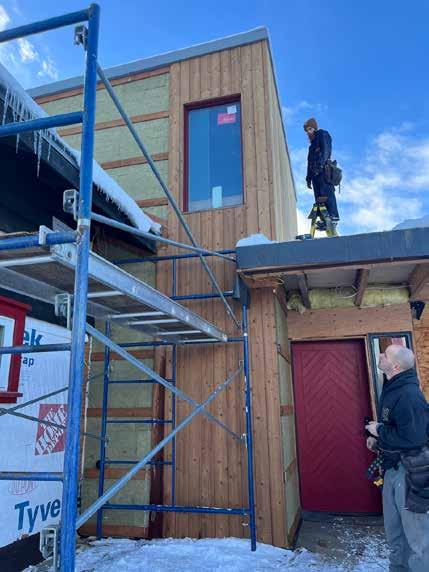
nervous” before the group’s first meeting, she said. “The whole point of the group was to share ideas, experiences, and best practices. Would people share their trade secrets?”
The answer was a resounding “yes,” Peterson-Aspholm soon learned. “Everyone is incredibly generous. It’s really nice to see; it feels so collaborative.”
Peterson-Aspholm’s philosophy about the group had been “a rising tide lifts all boats,” and she was encouraged to see this manifest even at the first meeting.
“It was about half designers and half architects,” she said. “Right away the architects started learning from the builders about how to be realistic in our designs, and builders began learning from designers about how to install some of the features and systems incorporated into house designs.”
outside expertise for presentations, such as a recent information session with Bellingham-based 475 High Performance Building Supply, which specializes in sustainable building materials and systems. “That was really fun and informative,” Peterson-Aspholm said.
Peterson-Aspholm acknowledges the role expense plays in building energy-efficient homes. “We’re always up against the cost issue. It’s crazy how expensive things are,” she said. “$400 a square foot is a really tight budget these days. You can get away with cheaper materials, but they don’t have longevity, so they end up costing more in the long run.”
“We have really spirited discussions about the energy code,” Peterson-Aspholm said. “It’s a really big challenge. We want to be able to build affordably, but the up-front costs can be considerable. But anyone building at volume should really be paying attention to the energy code.”
Some of the building materials and systems — such as heat pump water heaters — are twice or thrice more expensive to install, but they are 10 times as efficient to run. Long-term savings are available, if the initial cost can be absorbed into the overall building budget.
“You’re trying to thread the needle, with the goal of building the most durable, efficient house you possible can,” Peterson-Aspholm said.
The “biggest bang for your buck, efficiency-wise,” Peterson-Aspholm said, “is a well-sealed, well-insulated thermal envelope. Don’t skimp here. Attention to walls, roof, floor, and windows materials — get the absolute best windows you can afford — and careful installation will lower operating costs for the house by reducing energy demand and will make the house more durable.”
“Ancillary to this overarching recommendation is the need for effective ventilation,” Peterson-Aspholm added. “The more you insulate and seal, the more effective is the thermal envelope, but you should still have concerns about moisture trapped in the wall. We don’t have muggy humid summers here, so most moisture getting into walls comes from the interior in the winter — our wet snowy clothes and wet dogs, for example.”
Other energy-friendly no-brainers, Peterson-Aspholm said, are “Build smaller. Use window glazing judiciously. Go all-electric for equipment and appliances. Consider renewables. If you have a good solar aspect, incorporate that.”
“Everyone is so generous with their intellectual property,” Peterson-Aspholm continued. “It’s like everyone realizes we’re all in this together — this goal of building better houses.”
The MVBS group has been meeting almost monthly for a year now, and in that time they have addressed best practices for energy efficiency, increasing durability, Firewise practices, preventing mold, and other topics. They have incorporated site visits into their schedule, touring projects that local builders are involved in, such as homes with double stud walls and houses with rigid insulation on the exterior.
“Site tours are really useful,” Peterson-Aspholm said. “Builders can do a show-and-tell and share their tricks of the trades. The rest of us get these little gems of wisdom on these site visits.”
Sometimes the MVBS brings in
For this reason, Peterson-Aspholm hopes to attract more tradespeople — particularly plumbers and electricians — to the group.
“This is all really new for a lot of people,” Peterson-Aspholm said. “Not everyone has installed heat pumps, for example, so there is a fear of them. But we’re all learning and sharing information and it would be great to have tradespeople involved in the conversation.”
Peterson-Aspholm said that energy codes are using “the carrot rather than the stick approach” to push designers and builders into creating more energy-efficient homes that are less dependent on fossil fuels.
“There is essentially a menu of energy efficiency measures that you can dip into, each with positive or negative points assigned to it,” Peterson-Aspholm said, noting that it helps to build a house smaller than 1,500 square feet because you only need a total of three points, whereas a building larger than 1,500 square feet needs six points to meet code.
Upcoming discussions at the MVBS group meeting include conversations about carbon footprints and penciling out the impact of the materials used in homes.
“For example, you might have a 5,000-square-foot, net-zero home [a home that generates as much electricity as it will use in one year], but that large home is using a lot of resources in other ways, in terms of embodied carbon and energy use, so does that really make sense?”
Peterson-Aspholm asks. “Should we be building anything that is not small and energy-efficient?”
Peterson-Aspholm, Kollmeyer and Newman are hoping to cast the net wider and generate even more interest in participating in the MVBS group. “Anyone is welcome!” Peterson-Aspholm said. “We’re all just learning from each other in a non-threatening environment.”
For more information about the MVBS or to get involved in the group, contact: margo@pbwarchitects.com.
The creativity and craft of home designers and builders will be on full display for the 21st annual Methow Valley Home Tour, presented by The Confluence: Art in Twisp on Saturday July 6, from 10 a.m. to 4 p.m.
The homes on the 2024 Home Tour feature the variety of architectural styles, building materials, sizes and landscapes that can b e found in and around the community of Winthrop. Among the h omes featured, attendees will be treated to touring a cozy, gabled cabin in the trees, a glassy, view filled home in a field, and an art filled, courtyard house. In conjunction with the
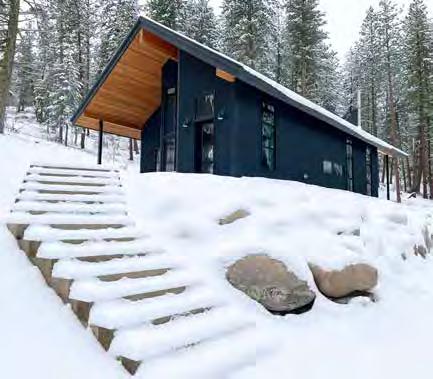




Saturday tour, The Confluence: Art in Twisp will host a series of talks free to the public on subjects ranging from architecture a nd design to selecting art for your home collection. Topics and dates to be announced.
Tour tickets are available now through Brown Paper Tickets, or at The Confluence: Art in Twisp from June 13 to July 6. All attendees must pick up their wristbands a nd Tour Guides at The Confluence prior to the Tour. Tickets and w ristbands will also be available for purchase on the day of the tour, July 6, from 9 a.m.-noon at the Mazama Store. Participants should be 12 years of age or older.
Tickets are $30 per person; or $25 per person for a carpool of four or more; or $25 per bicycle. Touring by bicycle and carpooling are strongly encouraged.

 Photos courtesy of Prentiss Balance Wickline Architects
Photos courtesy of Prentiss Balance Wickline Architects

Austin residents Ellie and Bob were looking for an escape from Texas’s hot-asHades summers when a visit to old friends brought them to the Methow Valley. One of those friends is architect Margo Peterson-Aspholm, a principal at Prentiss Balance
“They came out to visit us, and … as one does, they fell in love with the Methow,” she said.
The valley was a good fit for the couple, who’d grown up in small towns and wanted a peaceful getaway where they and their two children could spend summer and winter holidays close to nature. They started looking for land and found their place on a wooded site north of Winthrop.
Ellie and Bob loved the land and, in particular, the wildflowers carpeting the ground beneath the trees, and wanted to “build in a way that would keep the integrity of that land as much as possible,” Ellie said. They also loved Peterson-Aspholm’s aesthetic, and asked her to design their house.
As a designer, Peterson-Aspholm focuses on proper siting and design that fits the valley’s natural and cultural environment, reflecting
both rustic and funky flavors that have influenced designers like Doug Potter and Sun Mountain architect Roland Terry.
In addition, she said, PBW is “particularly interested now in centering sustainability and resilience in our work. … That’s partly just because it’s the right thing to do and it’s partly because it will save our clients money and headaches and increase the durability and the … cost efficiency of our projects.”
The firm’s work in the valley often features “relatively smallscale houses” and modest, “sometimes very tight,” budgets, said Peterson-Aspholm.
The owners and architect explored the 10-acre parcel, considering possible building locations and eventually identifying an elevated site with “the nicest views and the best light,” said Peterson-Aspholm.
Sheltered by a small knoll and overlooking a forested ravine and a hayfield-turned-meadow, the building site is private and less windy than much of the surrounding area — although breezes still move through the trees to cool the air on hot summer days.
Fitting the house to its sloping site was “a little bit of a masterclass … in topography,” said Peterson-Aspholm. The house steps up the hill in three levels, with a detached office and guest house occupying a fourth level at the top of the building site. The two buildings enfold a g rassy courtyard — the only real “landscaped” space on the site. Most of the parcel retains its native vegetation.
Peterson-Aspholm and builders Impel Construction planned carefully to minimize disruption and restore disturbed areas immediately. Saul Labanauskas of Brothers Fire thinned the forest, removing small-diameter timber to increase fire resistance while retaining the character of the wooded site. He was asked to leave two trees that are “probably too close to the house,” said Peterson-Aspholm, but enhance the setting and provide welcome shade.
Rob Crandall of Methow Natives

moved in to revegetate areas exposed by grading and trenching as soon as the site work was done, seeding native grasses and flowering plants and reducing opportunities for weeds to colonize the bare soil.
Designed for family living Immersed in its surroundings, the Wildflower House opens to the forest on every side. High ceilings and clerestory windows amplify the view of the surrounding trees. From a glass-paneled entry, the house steps down to an open living area and up to bedrooms and baths. A series of simple forms with concrete floors and wood paneled walls and ceilings, it’s a compact, clean-lined place whose warmth reflects the owners’ generous spirit and balances the austerity of the underlying concept.
Kitchen, dining and living spaces flow together on the lowest level — “where we all gather,” said Ellie. The room welcomes guests of all ages, cooking and music, books and games. Kids hang out there and do their thing, said Bob, and also take advantage of easy access to the outdoors.
A dark metal fireplace anchors one end; at the other, open shelves display Ellie’s pottery and vertical tiles provide a splash of muted color that plays up both the colorful glazes on the ceramics as well as the house’s connection to the surrounding forest.
At the heart of the upper level is the kids’ zone — two small bedrooms, closets and a nook that’s a popular gathering place for children and dogs. Pocket doors allow the childrens’ bedrooms to open to the adjacent hallway and the nook,


which holds a twin-sized mattress that can accommodate visiting cousins and friends.
The bedrooms are small by design
— they give each child a private space but encourage gathering in the nook or the family living space. Closets and other storage space are
outside the bedrooms in the adjacent hallway.
Beyond the kids’ zone, the primary suite is also modest in size, sparely furnished and secure in the embrace of the pines that surround the house. A high ceiling and tall clerestory emphasize the verticality of the landscape. Floor-to-ceiling windows meet at one corner, and sliding glass doors open to minimize the barrier between inside and out.
Tiles in the house’s two bathrooms and a vivid green mattress cover in the nook infuse the upper level with more splashes of color.
“I’m really pleased with the interiors,” said Peterson-Aspholm. “And I think a lot of it has to do with Bob and Ellie’s aesthetic choices. You know, their taste trends towards the modern, but a little bit of funky colorful details as well.”
Outside, a mix of stained-fir siding and decorative metal adds interest to the walls and highlights the expanses of glass that bring light and v iews indoors and let the family and their guests move in and out of the two structures with ease.
Metal roofs, hardened perimeters,





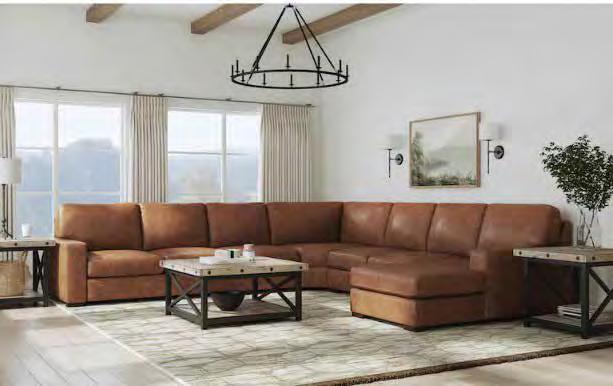
and concrete patios help keep both house and guest house safe from fire. “We always do metal roofs,” said Peterson-Aspholm. “That’s one of the best things you can do.”
The design does include some deep overhangs, she said, acknowledging that they are not ideal from a fire-protection standpoint. But, “there’s no place where they have combustible materials underneath the eave.” The ground beneath the overhangs is occupied by beds of river rock and large concrete pads that are both decorative and fire-proof.
Fine craftsmanship distinguishes the Wildflower house, said Peterson-Aspholm. Builder Donnie Wallis of Impel Construction “really put a lot of love into the details and the finish carpentry is just completely primo — perfectly done,” she said.
Impel project manager Peter Wallis credits Donnie and his crew of carpenters, saying that the extensive woodwork made it “important that people working on the house knew how to fit wood, precisely” and “the owners gave us the liberty to take what time it took” to do that work and produce stellar results.
Impel also relied on subcontractors for specialty work. Some of the most visible contributions include interior and exterior metal work by Matt Port of Bent Metal Services; roofs installed by Cascade Foam & Coatings; and shower glass placed by DR Glass Works out of Omak. Cabinets were fabricated by Griffin Cabinets of Seattle, and Columbia Cascade Plumbing was responsible for

installing pipes and fixtures.
The house’s heated concrete floors required special attention. “When we poured and finished the slab, that was also the finished floor,” said Peter Wallis. C arlton-based Five Star Concrete Construction created the foundations and floors at the start of t he job; the floors then needed to be protected while the rest of the house was built.
“That becomes a challenge, because you have all kinds of weather to deal with and subcontractors that



have heavy things they’re bringing to the job site, and you don’t want to scratch or bash or chip the concrete,” Wallis said.
T he Wildflower House was built during the pandemic, which affected every facet of the project, said
Peter Wallis. Visits by the owners were very restricted, materials were difficult to procure, and distancing requirements slowed production. With those exceptions, “I really felt like it was a very smooth project,” said Wallis.

Good communication with the architect and foresight on the builders’ part contributed to that success. Wallis collaborated with Peterson-Aspholm throughout the project and, in particular, relied on her as a conduit for communications with Ellie and Bob since the owners were out of state during most of the project.
Impel ordered building materials in advance, working with North Valley Lumber to source the fir and larch tongue-and-groove boards that cover surfaces throughout the house, and fir siding for the exterior.
Thoughtful design and careful crafting have wrought a robust, beautiful, and livable house, and guest and office quarters that gracefully accommodate both visitors and work.
After two summers in the Wildflower House, Ellie and Bob and t heir children feel connected to the house, the land, and the community. “It’s just really peaceful a nd quiet,” said Ellie. Unlike a
shrub-steppe or waterfront site, “we just get the ponderosa wind and so it’s really beautiful to be up there all summer long.”
Buffered by the knoll that screens the house from the road, “We feel like we’re just cozied into that beautiful property. And the kids … just love running around, finding bones and flowers,” she said.
Peterson-Aspholm commented from a visitor’s perspective: “ When you’re there … it’s pets and kids and people everywhere.” The house handles the activity well, she said. “It’s pretty resilient, [with] the concrete floors, and it’s not precious … it’s very, very homey. It’s modern, but homey, and has a little bit of that valley feel to it.”
Building the house was a great experience, said Ellie.
“I feel like Donnie [Wallis] really put his heart and soul into that building and it’s noticeable in the details and in how well it’s crafted, and it’s just nice to know that b efore we loved it, somebody else loved it, just as much,” she said.

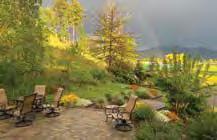
The high cost of homeowner’s insurance is something everyone loves to hate. Korrie Bourn, local agency owner of Winthrop and Twisp VIP Melbourn Agencies, says, “Over the past 12-18 months, we have seen homeowner’s insurance rates increase within the 2035% range.”
Every homeowner has felt that increase in the pocketbook. However, when the unexpected damage or destruction happens to your home or property, there is not a better feeling of relief than knowing the coverage is there.
If you have a home and a mortgage, your lender will require you to have homeowner’s insurance. Flood insurance will also likely be required if your home is in “A Special Flood Hazard Area,” as defined by the National Flood Insurance Program.
According to Bourn, with the increased risk of flooding in the numerous Methow Valley burn areas, a homeowner at risk may purchase extra protection for damage due to incoming water even though their property is not in a designated “flood plain.”
If you don’t have a mortgage, it


is still a good idea to protect your investment by buying homeowner’s insurance. Methow Valley is in a high-risk area for wildfire as well as damage from wind, snow and ice and thus an additional impetus to make sure a home is adequately insured.
There are several things to consider when making decisions about homeowner’s insurance. Numerous companies offer this type of insurance, and each will charge a different premium and offer different coverage. A licensed insurance
agent can help compare companies, premiums, and to make sure you have adequate coverage.
If you want full value of your property in case of a loss, you will need to buy replacement-cost coverage. A homeowner should be apprised of what it would cost to replace their home and be sure that current coverage is adequate.
Bourn says, “Think about what you expect to be covered and what you would want to be covered in a claim. Then talk to your agent about your policy to confirm whether you already have what you need or if you need to purchase additional insurance.”
She also recommends, “Review your coverage limits and policy forms, including listed exclusions, annually.”
Many companies place a moratorium on changes and new business w ithin the zip codes where there is an active wildfire. Bourn says, “This is another reason to review your coverage limits every renewal and, if your renewal falls within wildfire season, you should review your coverages in the spring.”
Even though reviewing your homeowner’s policy annually is recommended, Bourn warns that there are several reasons not to switch insurance companies yearly. She says, “You open your property up to an inspection from the new insurance company, you lose out on accumulating a renewal discount, and you may be grandfathered in at your location with your current carrier meaning you would not be able to purchase

a policy with them in the future. Additionally, you may switch to a new company to save on premium that year only to find your premium increases at the renewal due to a rate increase taken by the company or discounts that applied at the time of issuing your policy no longer apply.”
What’s covered
Homeowner’s insurance typically covers repairing or replacing your damaged or destroyed home including attachments such as garages and decks. Additional coverage is necessary to cover other structures including detached garages, workshops, barns, or attached fence.
Coverage for personal property includes such things as household furnishings, TVs, stereos, and clothing. There may be limited coverage for items such as jewelry, collectibles, art, and other valuables. Additional coverage can usually be purchased for a price.
Unfortunately, filing a claim runs the risk of an increase in premium when the policy renews and sometimes insurers may not renew coverage due to claims. A claim remains on an insured’s record for five years. A homeowner must weigh whether personally covering the cost is a viable option to risking a premium increase or loss of coverage.
A second part of homeowner insurance is liability protection in three different scenarios.
Medical payments will pay for medical expenses of others if they are accidentally injured on your property. Most policies include $1,000 of coverage, but higher limits can also be purchased. Generally, this applies to invited guests, not those on your property without permission.
There is also legal liability coverage
for damages caused by a hazard that you, as the homeowner, knew existed and someone got injured because of it. For example, if you knew you had a loose deck railing, someone leaned on it, fell, and was injured, you can be held liable. Most policies include $100,000 in liability coverage. Higher limits might be available.
Personal liability coverage extends beyond your property limits. If you or a family member who lives with you causes damage to another person’s property, this coverage may pay for the damage.
What is not covered by your homeowner policy can be a surprise if you have not read the policy carefully or discussed details with your agent. Bourn says the most common insureds’ misconception is that their policy covers such perils as “flood, landslide, and earthquake.” In fact, there are several major risks that a standard homeowner policy does not cover. For example, damage due to an earthquake, flood, f lood-related erosion, and mud flow, land movement or landslide, mold, and volcanic eruption are not covered under a standard policy.
Bourn says, “In most cases, these are excluded coverages and separate policies must be purchased.”
Winter weather can also cause damage requiring repairs ranging from minor to major. Some of the winter hazards that have arisen in the Methow Valley are falling trees (yours or your neighbor’s), collapsed carports, TVs or appliances ruined by power surges, roof damage from ice dams, and loss of refrigerated food due to a power outage.
Many homeowners do not realize that a car that is damaged, for example, by a collapsed carport is

not covered by the homeowner’s policy. The vehicle must be covered for physical damage on an auto insurance policy.
Another common winter hazard when temperatures dip below zero is frozen or burst pipes causing water damage. You are most likely covered, but there are exclusions you should be aware of. With many homes in the valley not occupied fulltime, a second or rental homeowner has the responsibility to keep the house warm enough in the event of freezing temperatures. Other precautionary measures may be required by your insurer such as ensuring your outside faucets are drained, covered, or insulated.
Bourn says regarding water damage from inside the dwelling, “Coverage for water damage is nuanced and comes down to the cause of loss. There may be additional water related exclusions on the policy that can be remedied with endorsements. It is best to discuss your concerns with your agent to verify what is available and decide if you want to purchase coverage.”
A few insurance companies offer a preventive service during threatening wildfires called the Wildfire
Defense Program. If you are with a carrier who offers this service, you are automatically enrolled. In the event of an active wildfire within a certain distance of your home, wildland firefighters contracted by the insurance company will provide support in protecting your property.
During Cedar Creek and Cub Creek fires in 2021, many vehicles providing this service were patrolling insured properties.
If you are a renter, not a homeowner, there is still reason to buy renter’s insurance. It provides coverage for both the renter and the landlord.
Bourn says, “The premium for a renter’s policy falls within a range of $150-$300 a year depending on the personal property limit and also provides personal liability coverage for the named insured.”
Homeowner’s insurance policies can be complex and confusing to the lay person. Because protection of your investment is imperative, especially in a high-risk area, making sure you have adequate coverage is of utmost importance. Your insurance agent will be your reliable source for the ever-changing landscape of insurance policies.


The Methow Valley real estate market appears to be making a slow recovery from the pandemic-driven fever of the past three years.
The land rush fueled by the migration of people seeking a home or vacation getaway during the pandemic shattered price and sales records as stressed-out buyers fought over the valley’s scarce supply of homes and land for sale.
The red-hot market cooled to something like lukewarm during 2023, mirroring national trends. Homebuyers in the Methow faced record high home prices, rising mortgage rates, and a historically low inventory of homes and land available for sale.
If trying to buy a home in the Methow Valley during the competitive frenzy of 2020-2022 was traumatic, trying to buy a home during the past year could be described as more of a bummer.
Stubbornly high home prices have barely budged since peaking at the end of 2022 at a median price of $640,000. The median price of listed homes in the Methow Valley in 2023 was virtually unchanged at $639,950, according to data
provided by Blue Sky Real Estate in Winthrop.
Given the limited supply of homes for sale and the continued demand, especially from the Seattle area, local real estate agents say they expect home prices to stay at current levels in 2024, or perhaps even creep up a bit.
The Methow Valley’s real estate market last year reflected a nationwide trend that industry experts described as “demoralizing” for aspiring buyers.
“The local real estate market in 2023 was discouraging for many buyers,” said Adam Rynd, owner/ designated broker at Coldwell Banker Winthrop Realty.
Buyers were disheartened not only by high home prices, but also by the Methow Valley’s “chronic lack of inventory,” said Alexis Monetta, managing broker of Windermere Real Estate in Twisp.
“Inventory is still historically lower than in past years. The market has still has not recovered to preCOVID inventory numbers. This has created a supply and demand issue and has been one of the driving forces for price increases,” Monetta said.
The combination of scant inventory, high property values, and m ortgage rates that climbed to almost 8% took a toll on sales in the Methow Valley last year. Sales
of homes and land fell in 2023 compared to the previous year, and were dramatically lower than the record sales of the pandemic buying frenzy in 2020.
“The volume was drastically reduced in 2023,” said Heather Marrone, owner/designated broker of Blue Sky Real Estate in Winthrop. “There was 30% to 40% lower volume than in 2022 depending on property type; 113 sold listed homes in 2022 versus 73 in 2023, and 68 sold listed land parcels in 2022 versus 47 in 2023. We have not seen that low of a volume in land sales since 2009.”
Last year’s sales of 73 listed homes compares to 137 listed homes sold in 2020, and the 47 sales of listed land last year compares to 132 properties sold in 2020, according to Blue Sky’s data.
The sales trends in the Methow area consistent with national trends, said Rynd. “According to the National Association of Realtors, homes sales dropped to their lowest level since 1995 in the United States ... down 19% from 2022,” R ynd said. “That’s directly a result of relatively high prices, low inventory, and higher mortgage interest rates. In the Methow Valley we actually saw a decline closer to
30% ... from 2022 to 2023.”
Higher mortgage rates depressed home sales in two ways, agents say. Prospective buyers went into sticker shock, and prospective sellers with low-rate mortgages decided to sit tight rather than sell their homes and finance a new home at a much higher rate.
“If someone had refinanced their home during cheap money years, they were very hesitant to sell a mortgage at 3% or 4% to buy a new home that they had to finance at 7% or 8%. That slows volume for sure,” said Marrone.
Nationally, almost 80% of mortgaged homes in the U.S. have rates at or below 5%, according to economists with Windermere Realty. “Sellers need some motivation to move with these lower rates,” said Monetta.
As mortgage rates climbed, many buyers felt like they’d missed their chance, realtors said. “New buyers couldn’t wrap their brains around how much less home they were getting.” Marrone said. “They were paralyzed by comparing the home they could have gotten ‘then’ versus how much home they could get ‘now.’ Or they just couldn’t afford to get into anything that suited their needs because the monthly payment was now out of reach.”
“ Potential buyers lose buying


power when rates are higher,” said Rynd. “For example, when a buyer borrows $500,000 at a 4% interest rate, their monthly payment will be just under $2,400; with an interest rate of 7.2% … they can only a fford to borrow $350,000 with the same monthly payment.”
Interest rates began dropping after hitting highs near 8% last year, and were in the mid-6% range in the first months of 2024. Although still above the rates many homeowners have locked in over the past decade,

the downward trend may be enough to push buyers and sellers to act during the coming year.
“Mortgage rates have dropped ... more importantly, buyers are adjusting to higher interest rates so it isn’t as much of a deterrent as it was when they first started going up,” said Ina Clark, owner/managing broker of Mountain to River Realty in Winthrop.
“Historically, 6% is pretty average,” Marrone said. “Buyers will probably have had the t ime they need, psychologically speaking, by mid-2024 to accept this and move on ... adjust their expectations.”
“We’re already seeing signs that the real estate market in 2024 will be much healthier for both buyers and sellers,” said Rynd. “Buyers who took a break from shopping in the last year are returning to the market now. I anticipate many sellers who have been waiting for better market conditions will list their property.”
Buyers continue to face home prices that remain at historic highs, limited selection of homes to choose from, and higher rates




to finance homes. But compared to the brutal bidding wars that characterized the sellers’ market during the pandemic, buyers are regaining some of the bargaining power they have had in the past, real estate agents say.
During 2021 and 2022, in the midst of the real estate frenzy, most homes had multiple offers, were selling above listing price, and cash buyers often won out. Many sellers wouldn’t even entertain the idea of contingencies or i nspections.
In 2021 homes were selling at an average of almost 6% over list price, and in 2022, homes sales were averaging almost 5% over list price, according to data provided by Blue Sky Real Estate. Land was selling over list prices as well; almost 5% over list prices in 2021 and 1% over list prices in 2022.
In 2023, the market began to rebalance, and homes were selling at an average of about 1% under list price, and properties were selling at about 5% below list price.
“Most all offers drafted in 2023 had inspections and contingencies attached. More than not had price negotiation,” said Marrone of Blue Sky Real Estate. “So, compared to the pandemic years, buyers had hugely more power than they had before. Many buyers had more negotiation power than sellers in 2023.”
Local agents say they are still seeing a lot of “cash” buyers, although that doesn’t mean someone with large amounts of money sitting in a checking account, Marrone said. Taking a second mortgage on a
home or getting investment-backed loans are common ways that people pay “cash,” she said.
“But we’re not in a market anymore that overwhelmingly favor c ash offers. Few properties get multiple offers any more. That is where cash is a big game changer. If there is only one offer, a f inanced offer looks pretty good. There are even loans now that can be presented as ‘cash.’ If you’re scratching your head, I get it,” Marrone said.
She said there are many creative loan programs now to help buyers get into a house, and she encourages buyers to explore options with a mortgage broker.
Across the country, areas like the Methow Valley experienced a “zoom town” phenomenon during the pandemic, attracting a flood of remote workers from cities to more tranquil settings. Now, real estate watchers report “boomerang migration,” with people moving back to their former communities, either out of desire or necessity. Local real estate agents say they aren’t seeing that play out in any significant way in the Methow Valley.
“We have definitely seen people who purchased here during the pandemic decide they are going to call Seattle their home base again. Whether for work reasons or for personal reasons, they need to be closer to the city,” said Marrone.
However, most people who were part of the valley’s zoom town rush “held onto their western Washington base,” and even if they are shifting back to their previous home, they are not selling t heir Methow Valley property, just changing how they use it or how much time they spend here, she

said.
Last year brought about a change in the way real estate brokers work with buyers, as a result of a new Washington law requiring brokers to enter into written agreements with buyers they represent.
Prior to the new law, a property owners listing property with a brokerage firm had to offer a buyer brokerage commission, which w as negotiable between sellers and listing brokers. That longstanding practice was challenged i n a number of lawsuits around the country, Marrone said.
Under the new state law, buyers must sign a buyer’s representation agreement with a broker w hen they start working together. The agreement outlines things like the timeframe for working together and the commission the broker will be paid by the buyer
if the seller is offering no commission or a smaller commission t han agreed upon between buyer and broker.
Marrone said the new law “has generated mostly productive early conversations” between buyers and brokers. However, lenders have not yet allowed buyer brokerage commission to be a line item eligible for f inancing, she said.
Clark, of Mountain to River Realty, said she worries that the new law might hurt first-time homebuyers, who “must come up with so many other costs when purchasing a home, from the down payment to lender fees and home insurance and reserve funds.”
Buyers who are reluctant to agree to a commission might decide to undertake the process of buying a home without a broker representing them, the local agents said.
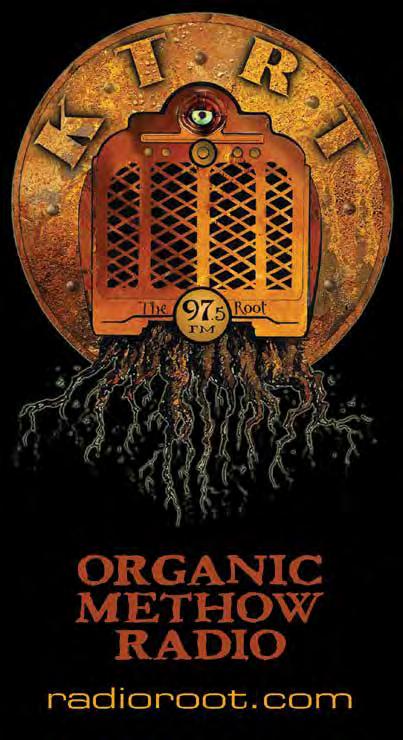





s the sun lowers behind the Cascade Mountains, the home hearth is where family and friends gather to enjoy evenings under the Methow Valley’s stunning night sky.
Imagine, falling asleep under the stars in the comfort of your own backyard, or enjoying a latenight conversation and cocktail
with views of the northern lights and Milky Way. The beauty of a home’s interior and exterior can be enhanced by views of the night sky and dark sky-friendly lighting to enhance stargazing from your own backyard. Creating an ecofriendly and comfortable nightlife at home is affordable and easy.
W indows are generally considered during daytime use for optimum lighting and warmth using the power of the sun. Those same windows and layout could
be enjoyed for an optimal view of the night sky: the Northern Lights, Venus rising in the west, or the moon rising in the east. To see these views at night, just turn down the interior and exterior lights. Skylights in a bedroom allow one to literally fall asleep under the stars in the comfort of their own bed.
The Danish concept of “hygge” in recent years can be created by home lighting designs. Creating
a cozy atmosphere to evoke comfort and a feeling of contentment does not mean “less light,” b ut rather, “smart light.” The two main guidelines to follow to create a homey atmosphere that celebrates the night sky are simple: use lights on the yellow spectrum, and only light the areas needed.
We’ve all heard the concept of “harsh lighting.” We feel different in certain lighting. Blue light is cool, yellow light is warm. The difference is all in the bulb, and which end of

Sun Mountain Lodge uses downward-facing lights on the warm spectrum for visitors to safely navigate walkways and entryways while enjoying the Methow Valley night sky.
the color spectrum the bulb emits light.
Medical studies show exposure to blue-spectrum lighting suppresses melatonin and increases risks for diabetes, cancer, obesity and other chronic conditions. The American Medical Association recommends only using warm lights with Correlated Color Temperature (CCT) of 3000K or less. C heck the label on the box of light

bulbs. Light color is measured on a temperature scale referred to as Kelvin (K). Lower Kelvin numbers mean the light appears more yellow; higher Kelvin numbers mean t he light is whiter or bluer. Warm yellow light is 3000K or less, blue like is over 4000K.
Within the home, this warmer low light can be achieved simply by swapping out light bulbs, using lamps or light strings to create an


Instead of an overhead floodlight to light walkways and gathering spaces, place light ropes under handrails to illuminate steps and porches. A path or fence line can easily be outfitted with small lamps to light the walk, just be sure there is a downward facing shade on the lights — no one wants to be blinded by a light pointed upwards.
Safety concerns is a valid reason to place outdoor lighting. The concept of less is more may seem counterintuitive, but evidence shows more lights do not necessarily create safe spaces. Too much glare makes it difficult to see.
Continuously lighting an area can actually increase crime. In many instances, outdoor lighting used at night is uncontrolled, inefficient, overly bright, poorly targeted, improperly shielded, and, in many cases, unnecessary.
Bright lights on the blue spectrum causes night blindness, and limits visibility outside of the lit area. A safer choice is to use soft yellow





health and safety, it also harms wildlife. Bright lights disrupt bird migration patterns, and the night life of insects, bats, fish, and salamanders. Owls will go elsewhere i f an area is overly lit at night. Bright lights at night disrupt the ecosystem If we want to enjoy the Methow Valley’s night life — not just the stars above, but the entire universe — only light the areas where a nd when needed, with light on the warmer spectrum.
• Timers and motion sensors. Studies show that a continuous light source does not result in less crime. Your property is more likely to be protected by a light that i nstantly switches one when motion is detected. Motion sensors c onveniently turn the lights on when you come home or step into an area that needs illuminated. Use high-quality motion sensors that are adjustable to prevent turning on unnecessarily every time a cat casually strolls by on night patrol.
• Light only the area where

needed. Let’s be honest — no one enjoys a neighbor’s light shining into our space, or disrupting an evening of stargazing. Proper shielding directs light only on your property. The light should be aimed downward and not be visible except only where needed. An ideal lighting design illuminates only the things we want to s ee without the actual source of that light being visible, as our eyes will constrict to the brightest point of light.
• Minimize blue light emissions. The American Medical Association recently raised concern about exposure to blue light from outdoor lighting. The AMA recommends shielding all outdoor light fixtures and only using lighting with 3000°K color temperature or below. Doing so will also benefit the night time ecosystem.
Smart lighting at night reduces energy consumption and costs. By using timers, motion sensors, lower wattage, and shields, smart homeowners can reduce their energy consumption while also reducing light pollution.
• The Okanogan County zoning code states outdoor lighting, “shall be directed downward and shielded to minimize potential glare to motorists and off-site residents. No exterior light with a direct source visible from a neighboring property shall be installed. Indirect sources and horizontal cut-off fixtures are recommended to reduce glare and provide general ambient light.”
• The Methow Dark Sky Coalition follows the recommendations of the International Dark-Sky Association — IDA — to educate the community on the impacts of artificial light and how to reduce light pollution through smart lighting practices. Guidelines from the IDA for outdoor lighting are intended for homeowners, designers, and contractors planning new construction or a remodel. Contact the local Methow Dark Sky group at www.methowdarksky.org/contact for more information on dark skies and technical assistance with lighting.
• Winthrop Ace Hardware and Methow Valley Lumber in Twisp carry dark sky friendly light fixtures and lights. Both local businesses will special order items if requested. The IDA website provides information on the dark sky fixture seal of approval program and dark sky retailers and provides information on over 1,000 dark sky friendly lighting fixtures for residential and business applications: www.darksky.org/our-work/lighting/.
You invest time, money, and energy in making your home a beautiful place to live. The beauty exists long after the sun sets and moon rises. Bring the universe to light by implementing lighting that is both beautiful and functional, without contributing to excessive light pollution.

Now more than ever, housing is at the center of community health. The data tell us and we feel it in the community: we are at a critical juncture for the future of the Methow Valley.
Now more than ever, with housing prices outpacing local wages 4:1 since 2018, the Methow Valley’s working class is increasingly facing the choice between sub-standard housing (including cars, couches and camping), living in cost-burdened poverty, or leaving the valley.
Now more than ever, the impact of the housing crisis on our local economy is evident in the number of businesses who close their doors for two or three days each week, even in peak season. Skilled positions — biologists, brewers, nonprofit leaders, educators — sit vacant, sometimes for years. Even those who can secure rental housing are often discouraged from taking long-term jobs without future ownership prospects.

Now more than ever, the impact of the housing shortage on our sense of community is palpable. Without a stable workforce, without the prospect of young people thriving in this valley, without the expectation that elders can remain in the place they have loved and tended, we are a community untethered from some of the most basic attributes that


make the Methow Valley a desirable place to live.
Now more than ever, we are paying attention and seeking solutions.

The problem is this: there is simply not enough housing — in both rental and ownership markets — within the financial means of those who derive their income
from local sources. The shortage of housing that is affordable for those who live and work in the Methow Valley is a real and tangible problem. But like so many other dilemmas the Methow Valley has faced, it’s one that we, together, as a community, can tackle. And the Methow Housing Solutions Network is ready to take the lead on designing and implementing a strategy.
Formed in the fall of 2020, the Methow Housing Solutions Network is currently made up of leaders from the Methow Housing Trust, Room One, the Methow Conservancy, TwispWorks, and the Housing Authority of Okanogan County. The Network is dedicated to raising community awareness about potential housing solutions and the possibility for purposeful, structural change. We’re now f aced with some real opportunities to make a dent in the housing c risis and we’re ready to engage the community in helping us chart a path forward.
Addressing the local housing
few of the Methow Valley’s most pressing problems have been easy to solve. We are confident that the creativity, ingenuity, resourcefulness, and imagination that h ave always characterized the Methow Valley’s problem-solving can be leveraged to, once again, transform an obstacle into an opportunity.
As we chart our path to addressing our valley’s housing crisis, we a re sharing different perspectives on challenges, solutions and opportunities.
Here are those voices; we hope you’ll listen to them.
Kathy (not her real name; she asked for anonymity in this article) has lived in the Methow Valley her entire life — so far. Born in 1962, she has “lived in a lot of houses in the valley in my lifetime,” she says, including the house she grew up in, which her parents purchased, brand new, in 1969 for $25,000 — about $200,000 today. Imagine that:
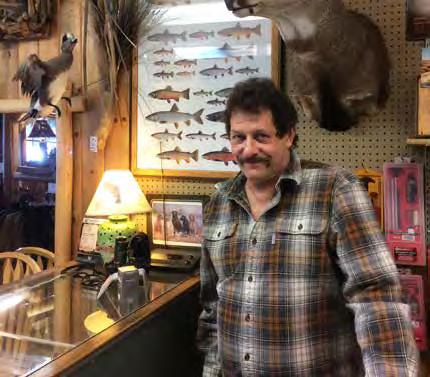

homes like that on the market at press time.
All these years later, Kathy still hasn’t found a permanent home.

rentals in the Methow Valley was hard for Kathy as a young adult raising her two daughters, but less because of affordability and




With 41 years in the Methow our experience makes the difference J. Bart

more because rental availabilities weren’t advertised; they circulated via word of mouth. Houses often stayed on the market for years, and owners would often rent the homes until they sold.
Rent was manageable, even on a tight budget. “I worked at Antler’s for 15 years and I worked seasonally at Pearrygin Lake State Park, n ine months on and three months off,” Kathy says. “It wasn’t a lot of money, but rent was affordable.”
When her children were young, Kathy says she lived in low-income housing. “A lot of my friends from work lived there too. We all raised our kids there, and as we got better jobs we moved on and got better housing,” she says.
Now, Kathy says, “Rent is just crazy. I cannot believe how bad it is. I’ve lived paycheck-to-paycheck, and now I see people all over the valley doing that.”
She has rented an apartment in Twisp for the past nine years. Located on the second floor, it’s not ideal for her, because she has trouble with her knees. Still, she says, “My rent is good so I suffer through the stairs and my neighbors help me. I’m in a sweet spot; it works for me. If I didn’t have this place, I couldn’t afford to be here.”
Kathy says she’s not sure if things will ever change for the better. Among her lifelong friends and acquaintances, she says, “I’ve seen a lot of people leave. They were in rentals, but when those rentals were put on the market in the past bunch of years they couldn’t afford to buy them, the prices were just astronomical. So they went to Omak. If you aren’t already established in a house here, you can’t get in.”
Senior housing — like Twisp Gardens, which is run by the Okanogan County Housing Authority — is attractive to Kathy. “We need more of that here,” she says. “Ours has a waitlist. But if you go to other communities, they have several different locations. They should build another one here.”
Kathy says she scours the Methownet bulletin board and the Methow Valley News each week, to see what the rental options are, but is always stopped short by the prices. She says, “You see what they’re charging for rent, and you just keep moving on.”
“Moving on:” precisely what Kathy has narrowly avoided doing for four decades. Weary of moving on, she simply wants the security of knowing she can remain in the place that has always been home.
Finally finding a ‘forever home’
When Lance Rider purchased The Outdoorsman, the outdoor outfitter retail shop on Winthrop’s boardwalk, in 2010, he d idn’t mind the commute over Loup Loup Pass from his home in Okanogan to the store, at least, not at first.
But after a couple of years of commuting 80 miles daily, coupled with a broken leg that made d riving difficult, Rider decided to relocate to his small camper, parked on a leased space near Winthrop. It was cozy, but it met his needs for all but the coldest winter months, when he resumed the commute.
“Then that got to be ridiculous,” Rider says. Rider was and is an outdoorsman, but sometimes enough is enough. In 2018, after eight years

of either making a daily commute or camping out, he decided to sell the house he owned in Okanogan and relocate full-time to the Methow Valley, making it both his personal and his professional home.
Rider soon learned, however, that the price he got for his Okanogan house wasn’t enough for a Methow Valley home. “The houses I could afford,” he says, “all had major issues and wouldn’t qualify for a mortgage.”
Rider finally found half a duplex with reasonable rent and spent three years living there. He got comfortable and thought of his housing as stable. His mother, however, wouldn’t let him grow complacent. “She kept saying to me, ‘The landlord can always make you move.’”
Turns out mom was right; the duplex went on the market and Rider couldn’t afford the asking price. It was back to the camper for Rider, although he upgraded to a 30-foot RV, which “seemed spacious com pared to the little camper.” He spent summers out on the East Chewuch and parked winters at the Pine Near RV Park, to take advantage of the hookups, laundry and bathhouse

Q: What is “affordable” housing?
A: “Affordable” assumes a household should spend no more than 30% of its income on housing expenses, which would include rent/mortgage, property taxes, and homeowner/renter insurance. For a household of two in the Methow Valley, where the Area Median Income (AMI) was $66.8K/year in 2023, “affordable” would mean no more than $1670/month in housing expenses (rent/mortgage, property taxes, and homeowner/renter insurance).
Q: I’ve heard of people who were able to sell a previous home to purchase an MHT home. How does this work?
A: MHT shares that every household has met its strict income and asset limits and submitted documentation to ensure that those requirements are met.
Every household is unique, with a unique history and set of circumstances. Sometimes, the applicants want to stay in the Methow, age in place, and continue to be a contributing member of the community, but their home is no longer working for them because they can’t navigate stairs, care for a large lot, or drive far out of town to a remote location. Usually, there was a mortgage on the previous home, and once they sell their home, pay off the mortgage and buy an MHT home, the household is significantly below the asset limit.
Finally, only a small percentage of MHT homeowners are people who have sold their previous homes to purchase an MHT home.

Omak, where it was more affordable, but the commute costs money. I supported the MHT because I thought it could help people like that.”
At the time, Rider didn’t really think of himself as a potential



There are many collaborative efforts underway to address the Methow Valley’s pressing housing issue. They include:
• The Methow Housing Solutions Network Roundtable Discussions, a consortium of nonprofit organizations, builders, businesses, and others who meet every other month to share information about affordable housing solutions in the valley.
• The Methow Housing Trust’s construction of 45 permanently affordable homes, with another 55 to be completed by 2030, have allowed educators, servers, bakers, healthcare providers, and retail workers to become homeowners: www.methowhousingtrust.org.
• The Housing Authority of Okanogan County’s plans to build 22 units of multi-family housing near Winthrop addresses low-income housing needs: www.okanoganhousing.org.
• Methow at Home’s partnership with Silvernest matches homeowners with tenants: methowathome.clubexpress.com.
• Jamie’s Place Adult Family Home purchased two tiny homes for caregiver lodging, thanks to a Game Changer Grant from the Methow Valley Fund (jamiesplace.org).
• Some residents are building an accessory dwelling unit (ADU) to rent to a local resident; others have converted their ADUs from nightly rentals to long-term rentals. Still others have restructured their homes to provide a long-term rental space to locals.
MHT client, but a few years later, during a Give Methow crowdfunding campaign, as he was online m aking his donations from his RV, Rider noticed the “Apply” button on the MHT’s website. He applied, and after more than two years on the wait list, on Halloween 2023, Rider finally closed on his home in the MHT Evergreen Loop neighborhood in Twisp. He moved in the next day.
“Every day after work I walk in the door and say to myself, ‘Ooh, pretty.’ It’s well-built, really high-quality,” Rider says.
Having stable housing has been “a total attitude adjustment,” Rider says. “No matter what happens, at the end of the day I can go home, where it’s warm — it’s really nice.”
Anyone who lives in the Methow Valley long enough comes to recognize how real the affordable housing struggle is for the local workforce. So widespread is the awareness of the housing crisis that when someone with unstable housing finally lands in something more secure, it is seen not as a n inevitability, but instead as a
triumph.
On Nov. 1, 2023, when Rider showed up at the storage unit where most of his worldly possessions had been stowed for the past five years, the business owner cheered for him, saying, “Congratulations on getting out of storage.”
Energy efficiency and affordability
Measures taken for energy-efficiency in new construction are often touted as cost-prohibitive and therefore inaccessible to those building on a budget, but designer/builder Jeremy Newman of Intrinsic Design says the opposite is true. “The more energy-efficient we make our houses, the more money stays in pockets for day-to-day living expenses,” he says.
Newman points out that in an energy-efficient home designed for durability, “efficiencies are maximized to have a low operational cost in the end.” He cites high-quality windows and good insulation as examples.
“You can skimp in these areas, but over the long run it will cost you $200 a month extra in heating and
cooling bills. That’s $200 in groceries that could have been put on the table every month.”
Newman says the question that guides him in designing and building “pretty darn good homes” is this: “How can we do best for the planet, consume as little as possible, and keep as much money in the residents’ pocketbooks from month to month?”
Newman has taken “deep dives into Passive House,” which prescribes the strictest standards of energy efficiencies. “It’s a high standard to meet, and not really practical in an affordable housing sense,” he says.
Still, Newman is adamant that building responsible houses with high energy efficiencies is both possible and economical, especially when building at scale, such as when designing and building neighborhoods, rather than individual houses. He cites examples of Net-Zero communities, where homes produce the same amount of energy that they consume in a year. “There are these big ideas coming out of small communities like ours,” Newman says.
“Many people don’t realize that

In 2023, Room One supported 36 households with eviction prevention financial support, deposits/first month’s rent, and emergency motel stays, totaling $24,429, as well as helping clients more than 70 times with housing planning. There are many reasons someone may have difficulty covering rent month-to-month: decreased work hours or loss of work, changes in household composition, illness or health changes. Some people can qualify for assistance from the state or government when their health prevents them from working, however, this assistance is rarely enough to cover their rent.
Other situations may involve people seeking help with immediate shelter due to physical or emotional safety and experiencing a sudden loss of housing. Some individuals had been homeless for months to years or bouncing around (couch surfing) until they found a better housing option and needed help with first month’s rent or deposit. With most rentals requiring first and last month’s rent, plus deposit, it can take considerable resources to move somewhere new. People find creative ways to keep their place, either by selling belongings, accessing family if they have any, working under the table if they can, or remaining in an unsafe situation to maintain shelter.
Okanogan County participates in a statewide count of homeless individuals each year in the month of January. Room One took the lead in our area with the help of The Cove, Aero Methow, and the Methow Valley School District. While the County results will not be available for several months, here is a summary of information of the 29 households (35 people total) that Room One spoke with in the Methow Valley:
• 10 identified living in homes without access to water, electricity, restroom, ability to bathe
• 2 identified living “out of doors” such as a tent
• 5 identified living in their vehicle
• 6 identified living in a RV without access to water, electricity, restroom, ability to bathe
• 6 named that they are temporarily living with family or friends
• 8 youth were housing-unstable
In rural areas like the Methow Valley, homelessness is not centralized — there are no shelters or other areas where people can congregate — and it can be especially difficult to get an accurate count. The reality is that homelessness has many “invisible” variations in rural areas that do not always align with the definitions or images that are most frequently understood in urban settings.

the path to Net-Zero is simpler than they think, and the up-front cost may be less than they think,” Newman says. “The cost savings come f rom all other directions.”
Newman mentions the 30% federal tax credit on solar arrays, for example, as well as the use of geothermal loops.
Geothermal loops — pipes and fittings buried below the frost line, where the earth maintains a fairly steady 50-55 degrees — are one way to serve a community with heating and cooling efficiencies. The Department of Energy (DOE) describes geothermal heat pumps as using “the relatively constant temperature of the earth as the exchange medium instead of the outside air temperature.” Although the pumps are several times the cost of an airsource system, “the additional costs may be returned in energy savings in five to ten years,” according to DOE.
Newman believes that these types of efficiencies can be — and should be — part of affordable housing designs. Collaboration among architects, designers, builders, and systems installers is key, he says. To this end, Newman is working with architect Margo Peterson-Aspholm and designer Kit Kollmeyer to facilitate the Methow Valley Building Science group (see separate article, page 17). The group, which explores topics like building for efficiency and durability, uses the expertise and experience of a community of local building professionals to share information about creating a “pretty darn good house”: highly energy efficient, durable, inexpensive to heat and cool.
“There is this continual evolution in working through these ideas collectively,” Newman says. “We’re always keeping affordability in mind; we’re always asking ourselves, ‘how can we keep the construction expense and the operating expenses affordable?’”

They don’t have all the answers yet, but by sharing strategies and leveraging collective brain power, they have a great start. At the end of the day, Newman says “you end up with a beautiful Net-Zero house, and more money left in your wallet.”
The old adage that good fences make good neighbors might not always hold true. Sure, sometimes a good fence is just what is needed to keep livestock out of sensitive habitat or to keep the neighbor’s dog from digging in your garden. But sometimes, removing unnecessary fencing is the best way to care for your neighborhood.
Derelict barbed wire, in particular, can be especially pesky and even deadly. Since entrepreneur Joseph Glidden first filed a patent for mass-produced barbed wire in 1874, countless wild animals and birds have been killed by encounters with barbed wire.
Today, an estimated 620,000 miles of barbed wire crisscross the American West: enough to reach the moon and back, with a handful of quick wraps around the earth to boot.
The Methow Valley is no exception to barbed wire’s knotty legacy.
Although there has been no recent comprehensive fencing survey in the Methow Valley to provide data, anyone who has ever traveled the back roads, trails, and fields is aware that this valley, too, was once and continues to be delineated by a web of wire.
With the purchase of the Sunny M Ranch, the Methow Conservancy became the owner of hundreds of acres of agricultural land and the miles of fencing that have for generations prevented horses and cattle f rom accessing crops or disturbing sensitive habitat areas. Some of the fencing remains essential, but much of it is no longer necessary.
As part of our ongoing fencing inventory on the Sunny M, we have been working with volunteer crews to remove sections of unneeded fencing, partly in pursuit of

cleaning up debris, but mainly as an essential component of our commitment to wildlife and their habitat. The Sunny M Ranch is home to hundreds of species of mammals, birds, and amphibians, including large, wide-ranging species whose movement patterns and access to food and water is jeopardized by barbed wire. Removing this wire frees up wildlife passage considerably, especially for the charismatic megafauna.
When fencing is necessary — such as a means of keeping
domesticated animals out of ecologically sensitive areas or cultivated fields — we are working with a fencing professional to replace standard barbed wire with wildlife-friendlier options, which are still effective at keeping cattle or horses in (or out), but which give wildlife access to breeding and birthing grounds, seasonal habitat, and water sources.
Along boundaries of neighboring properties with limited l ivestock use, we’ll use a 3-strand smooth wire fence design, which allows for easy wildlife passage. Finally, we will install extra gates
in our fencing, to be left open in the winter when there are no livestock to exclude from a particular a rea. That way the wildlife can just walk through the open gates and not have to wriggle under or jump over the livestock-exclusion fencing.
We hope to use fencing removal and wildlife-friendlier fencing on the Sunny M Ranch as a model for other community efforts, to inspire those with derelict/unused f encing to pull it out, and those with necessary fences to begin converting to fencing that is designed and installed according
to some suggestions from Wild Aware Barbed Wire Warriors (wildaware.org/barbed-wireprojects) via Colorado Parks and Wildlife (cpw.state.co.us/).
When fencing is necessary, it should:
• Be highly visible to ungulates and birds.
• Allow wildlife to jump over and crawl under.
• Provide wildlife access to important habitats and corridors.
• Have a top rail height of 42 inches or less.
• A llow at least 12 inches between the top two wires.
• Allow at least 16 inches between the bottom wire and ground.
We are inspired by other communities where large-scale wire removal projects have been successful due to citizen engagement. The Jackson Hole Wildlife Foundation, the Oregon Desert Natural Association, Wild Aware, and others are helping inform our strategy.
As we learn more about wildlife-friendlier fencing efforts, and as we build our team of volunteers trained in barbed wire removal, we hope you’ll join us on the journey.
No fences to deal with? Here are a few other ways you can learn to be a good neighbor in the Methow Valley, by engaging with, learning about, and investing in our shared home and its history:
• Learn about the First People who made the Methow Valley their home: Confederated Tribes of the Colville Reservation, www.colvilletribes.com. The Methow Conservancy is grateful for the Methow People’s careful stewarding of and steady presence on this land and hopes to learn from their example.
• Visit the Methow Valley Interpretive Center to learn more about the human and natural history of the Methow Valley: www.methowvalleyinterpretivecenter.com.
• Tour HomeStream Park, which was created to honor the rivers and fish of the Methow Valley and the Native people, both past and present, who have called this place home for thousands of years: www. homestreampark.com.
• Read about Hummingbird (x ̌w námx̌w nam), which is 328 acres of ancestral land that was recently returned to the Methow People: methowconservancy.


org/news/entry/faq_land_justice.
• Visit the Shafer Museum to learn more about the Methow Valley from the 1880s to the 1940s: www. shafermuseum.org.
• Read more about the Methow Valley’s economy in the TwispWorks Economic Study: www.twispworks.org.
• Get familiar with the Methow Conservancy’s State of the Methow data collection project: methowconservancy.org/state-of-the-methow.
• Protect our dark skies by using only the lighting you need, aiming lights down, and using timers and/or motion sensors: www.methowdarksky.org/.
• Learn about all of the Methow Valley’s nonprofits and find one (or more) that inspire you: www. volunteermethow.org.
• The Methow Conservancy’s new Good Neighbor Handbook (www.methowconservancy.org/ goodneighbor) shares an ethic about living thoughtfully with wildlife, with neighbors, and with the community.


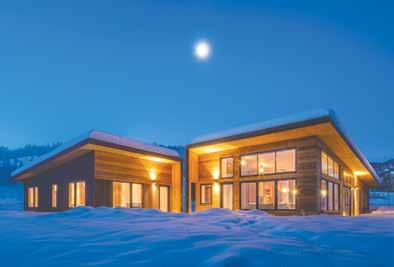

Sustainable building practices are being embraced by more builders, architects, and homeowners these days, becoming the rule rather than the exception in our own beloved valley.
Part of this is driven by ever-more rigorous energy codes, but it also reflects individuals’ desires for a healthier environment and smaller energy footprint. We want less waste and less pollution, and since the building industry accounts for a full 40% of C02 released into the atmosphere, making strides in sustainability can at least help slowdown the warming of our planet.
There are a few formats that are useful in quantifying what it means to build sustainably. Some are easier to implement than others.
Built Green certification, championed by the construction industry, has a range of certifications ranging from those that are self- reporting to more stringent certificates requiring third-party verification.
Beyond this basic and universally accessible template are programs like LEED (Leadership in Energy and Environmental Design) and LBC (Living Building Challenge) that are more demanding. The former is a common requirement for publicly funded projects but can be
applied to private developments and even homes.
LEED offers a range of certifications from LEED Certified to Silver, Gold, and Platinum. The same organization that established LEED went on to form the I nternational Living Future Institute, which in turn developed t he Living Building Challenge, the most rigorous sustainability certification.
LBC certification requires a third- party verifier, engagement with the Living Future Institute, and a commitment to not only be sustainable in terms of energy but also to avoid a Red List of materials that we now know pollute our e nvironment, sometimes forever.
These include vinyl and plastics, extractive materials that, through processing, damage our atmosphere, and others that damage our environment in any number of secondary ways.
There are also energy-focused sustainability programs like the Passive House concept, which creates a standard of building that results in ultra-low energy use and is widely used in Europe.
A decade ago, this environmental sensitivity was viewed as having a marginal impact. Housing developers viewed sustainable design as a 10% cost increase that could not be recovered.
Today, most occupants of buildings and consumers of building-related products feel that sustainable
design is worth whatever it might cost. In practice today, many sustainable strategies do not cost a significant amount more than conventional processes, and in the context of life cycle costs, many of these strategies save money in terms of ongoing operating costs and reap benefits in health, both for people and the planet.
To build sustainably, the first line of defense is the building envelope. Starting with a tight, well-insulated building is essential. Adding exterior layers of insulation to eliminate thermal transferal and “super insulating” walls and roofs can go beyond levels required by building codes, though codes are finally catching up with the need for tight building envelopes.
Materials used to address air infiltration can solve some problems but create others. For example, after it is installed and cured, the modern iteration of spray foam is a healthier material than in the past, but it is still not recyclable. For projects that prioritize recyclability, ventilated roofs using insulations made f rom hemp or wool are now more common.
Where we once blithely punctured interior air barriers to install outlets and light fixtures, now we use advanced materials that can be sealed around those penetrations with no detrimental effects to the building


envelop. Today, “blower door tests” are required to ensure envelope efficiency in many jurisdictions. These tests measure the amount of air leakage a building might incur. The less leakage, the better the building is at conserving energy. from an energy standpoint.
Windows, as much as they are prized for providing light, views and thermal gain on a cold sunny winter day, at times seem in conflict with energy efficiency. But a modern glass wall can be made from high performing triple glazed, argon-filled panels that are as efficient, or more so, than the opaque walls of times gone by.
In Washington (a state known for its stringent energy codes) window packages must average a U-value (a measure of thermal

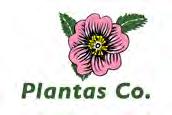
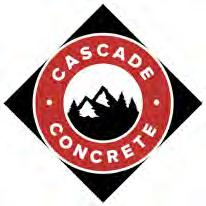
transmittance) of under .3 — the lower the U-value the better! Today, Passive House certified window systems can drop this figure by as much as 30%. For comparison, the U-value of an uninsulated s olid brick wall is 2.
The requirement for much tighter buildings has caused products and industries related to indoor air quality to evolve and diversify. An old house might have exchanged interior air for fresh outside air as often as one or two times an hour, simply through natural venting.
Today, that cycle has been reduced to .35 air changes per hour. According to ASHRAE (American Society of Heating, Refrigerating, and Air-Conditioning Engineers) standards with many buildings achieve rates as low as .2 air changes.

interior heat and infuses incoming fresh air with that heat.
The most exciting and sophisticated developments are in heating and cooling systems. Outdated systems employed gas or oil to heat air and circulate it with fans around the building. Cooling was delivered with energy intensive air conditioners.
The modern solution, the heat pump, is a descendant of the old AC unit. Heat pumps pull heat out of the air via a fluid that expands outside and, when compressed inside, releases heat. Conversely, the heat pump can pull heat out of inside air and release it outside when in cooling mode.
These systems can now heat air when outside temperatures are as low as -5 Fahrenheit. They do decline in efficiency over time, but heating when outside temperatures are as low as freezing is nearly free, expending a small amount of energy in pumping fluid and compressing that fluid in the process.
Likewise, cooling comes at a low cost. Heating and cooling is becoming much more efficient than it was *Sand


While a tight building envelope leads to saving energy, modern buildings need systems to exchange air without losing energy. The answer: energy recovery ventilators and heat recovery ventilators. These systems release interior air through a heat exchanger that extracts
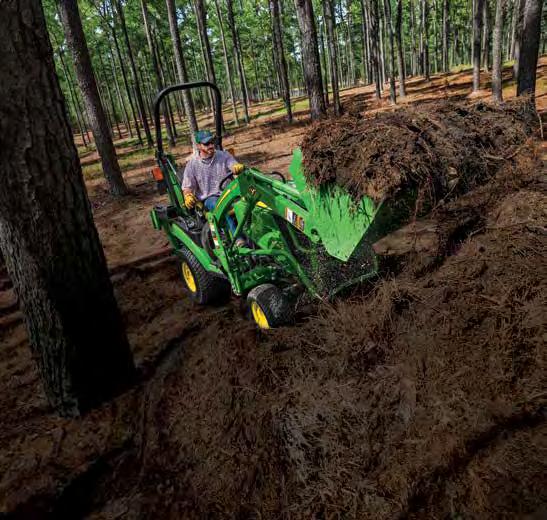

with our old gas and oil forced air furnaces.
Heat pump technology continues to evolve. Heat pumps can now be purchased to heat potable water. And, with an electric backup boiler, they can deliver radiant heat via tube systems in the floor or via efficient radiators. Heat pumps that pull heat out of the ground or bodies of water are costly to install but tap into a virtually inexhaustible source of energy at a small environmental cost.
What about other building components that have been detrimental to our environment? Arguably, the material with the largest environmental impact is concrete. Each pound of concrete created releases .9 pounds of CO2 into the atmosphere.
Today, by replacing the cement binders in concrete, companies like C-Crete Enterprises are transforming concrete into a material that is either carbon neutral or, in some instances, fixes more carbon that is released. C-Crete Enterprises is just one of several companies pursuing
the same strategy: reducing the carbon footprint of buildings through new concrete technology.
We have learned a lot about the toxicity of common modern building materials over the last few decades. For example, past formulae for spray foam and various glues contained formaldehyde. Formaldehyde, while common in nature, can be damaging to the ozone layer of our atmosphere and, in higher concentrations, is a known carcinogen.
Small quantities of this chemical exist in wood and other natural products, but in recent years it has been eliminated from spray foam products and minimized in exterior sheet-goods such as plywood, leading to safer built environments. Other chemicals in the VOC category (volatile organic chemicals) used to be present in most carpets and paints. Today one can avoid these by using low-VOC or VOC-free interior products.
A commitment to sustainable design and building includes living
within a larger environment. We can orient our buildings to take advantage of natural shade and solar heating or cooling. We can plant trees to create shade to help reduce heating loads and nurture native plants to benefit wildlife and restore damage caused by construction.
When we add the use of reclaimed timber, recyclable steel and aluminum, and products made from recycled content, as many textiles and finish materials are today, we create a path toward a much more sustainable future.
What if our presence on this planet is symbiotic rather than extractive and destructive? What if we use our wisdom to create climate neutral habitats for ourselves? What if we find ways that benefit both our existence on the planet and enhance the survival of the biome around us?
Our technology, creativity, and scientific knowledge, coupled with a re-discovery of some traditional materials and methods, can help us live (and build) more lightly on the land.
Ray and Mary Johnston are principles in Johnston Architects.
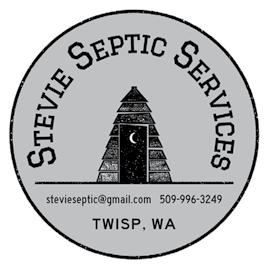



 Photos courtesy of Serious Fun Studio
Photos courtesy of Serious Fun Studio

Not long after Sarah and Brian Hunter laid the concrete pad for their new home in Liberty Woodlands near Mazama, flames from the Cedar Creek fire crackled on the ridge behind their lot. The
boundary of their property with U.S. Forest Service land became the fire line. “You can imagine,” Sarah said, “we had second thoughts.”
But this home nestled in the woods was designed to resist fires. The Woodlands is a Firewise community.
Brian Hunter’s grandparents were
ranchers in the Okanogan Valley, but Sarah was from back East. Brian introduced Sarah to Okanogan County, and they were married at the Freestone Inn.
Living in Seattle, both harbored dreams of having a second home in the Methow Valley, and that dream came to fruition in 2020 when they bought a lot in Liberty Woodlands. The lot was sold to them by a
builder, Cory Spellman, of Spellman Construction, who said he would build their home. Brian would function as the project manager.
“Minimalist, airy, clean lines with an indoor/outdoor feel,” was how Sarah described her design concept. The Hunters wanted a carport and a detached guest house and the modern, clean look and snow handling features of a shed roof structure.
They took their ideas to Kit and Sam Kollmeyer of Serious Fun Studio at TwispWorks who, Sarah said, “hit it out of the park” with their three design options.
On their website, Serious Fun Studios notes that “The spirit of collaboration and enthusiasm for the entirety of a project from an idea’s inception to its finest detail are what drive the studio’s continued pursuit of designs that are seriously fun.”
The Hunters were the Kollmeyers’ first clients to choose one of the three proffered designs with only slight modifications.
“The Hunters had a clear vision of what this home would be for their family,” Sam said. “When we work with a client, we talk about their needs, how they want their house to look and feel. We visit the site and experience what that feels like, and then present two to three design concepts — sometimes four — and work collaboratively from there to make the perfect plan for them.”
The Kollmeyers not only design to meet their clients needs, but also to make their projects fire-resistant and energy-efficient with passive solar features. They optimize the placement of the home to take advantage of views with windows situated so that they’re letting in plenty of light in the winter and not blasting heat in the summer.
The Hunters’ home is actually two structures connected by a covered walkway: a 235-square-foot g uest house and a 1,500-squarefoot primary dwelling. The home is situated to capture different views around the property so it’s like a modified pinwheel, giving privacy along the backside but capturing the views of the hill behind it.
Firewise features of the Hunters’ home include fiber cement siding by Allura, a standing seam metal roof, a concrete pad, and hardscape and native plantings surrounding the house. The only exterior wood is the soffit lining the covered walkway leading from the carport to the detached guest house to the entryway of the main house.
Sarah wanted a detached guest house for the privacy and convenience of her guests. The guest


house, accessed via the covered walkway, contains a queen size bed and a small bathroom. It has concrete floors and radiant heating. Cozy — but perfectly adequate.
When you enter the main house, one is struck by the amount of natural lighting illuminating the home even in the middle of winter, and the feeling of being in close contact with the outdoors. Muted tones, spaciousness, spare lines, and an open floorplan create an ambience of order and harmony. This house can claim “Hygge.” The Danish concept of creating a warm atmosphere and enjoying the good things in life with good people is practiced here.
Just to the right of the entry, a mudroom invites you to sit on a bench and take off your shoes. Next to the mudroom is a small enclave that contains a screen and a couch that folds out into a bed. The rest of the floorplan is open: the kitchen, dining area and living area flow together — perfect for Sarah, who loves to cook and entertain.
The Hunters’ home features radiant heating in marbleized concrete f loors, a propane fireplace adding warmth to the main living area, and mini-splits in each of the two bedrooms. Extension of the concrete pad outside of the living room and master bedroom function as small patios.
The kitchen countertops are made from a quartz slab and the cabinets are plentiful, offering ample storage space. Two spacious bedrooms down a short hallway complete the rest of the house.
The Hunters moved into their new home in August of 2023, and they are still adding finishing touches. Sarah designed most of the interior and, although she’s drawn to its clean, minimalist lines, she wants to add some color and character with artwork.
Overall, Sarah said, they are happy with how everything turned out and are impressed with the quality of the construction. They love their community and are eager to take advantage of making new friends and engaging in all the recreational activities available in the valley.

